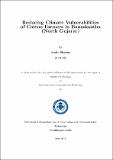| dc.contributor.advisor | Chaudhary, Sanjay | |
| dc.contributor.author | Sharma, Amita | |
| dc.date.accessioned | 2017-06-10T14:39:54Z | |
| dc.date.available | 2017-06-10T14:39:54Z | |
| dc.date.issued | 2012 | |
| dc.identifier.citation | Sharma, Amita (2012). Reducing climate vulnerabilities of cotton farmers in Banaskantha (North Gujarat). Dhirubhai Ambani Institute of Information and Communication Technology, ix, 40 p. (Acc.No: T00359) | |
| dc.identifier.uri | http://drsr.daiict.ac.in/handle/123456789/396 | |
| dc.description.abstract | The multiple regression models is used to analyze the effect of frequently changing weather,
like wide uctuation in monsoon rains, extremes in temperature, etc. on the cotton crop in
North Gujarat Region. The study is basically focused on Banaskantha district of North Gujarat
using data from 1991-2008. This study is conducted in two parts: (i) rst part contains
analysis on monthly rainfall with respect to cotton yield and (ii) second part contains analysis
based on different weather parameters like total seasonal rainfall, average temperature in
degree days, relative humidity, and soil moisture with respect to cotton yield. Results from
the statistical analysis are veried by the information collected from expert agronomists on
cotton regarding different growth stages and different requirements of cotton in those growth
stages | |
| dc.publisher | Dhirubhai Ambani Institute of Information and Communication Technology | |
| dc.subject | Cotton growing | |
| dc.subject | Gujarat | |
| dc.subject | India | |
| dc.subject | Climatic changes | |
| dc.subject | Environmental aspects | |
| dc.subject | Cotton | |
| dc.subject | Resilience | |
| dc.subject | Water | |
| dc.classification.ddc | 633.5191 SHA | |
| dc.title | Reducing climate vulnerabilities of cotton farmers in Banaskantha (North Gujarat) | |
| dc.type | Dissertation | |
| dc.degree | M. Tech | |
| dc.student.id | 201011025 | |
| dc.accession.number | T00359 | |

